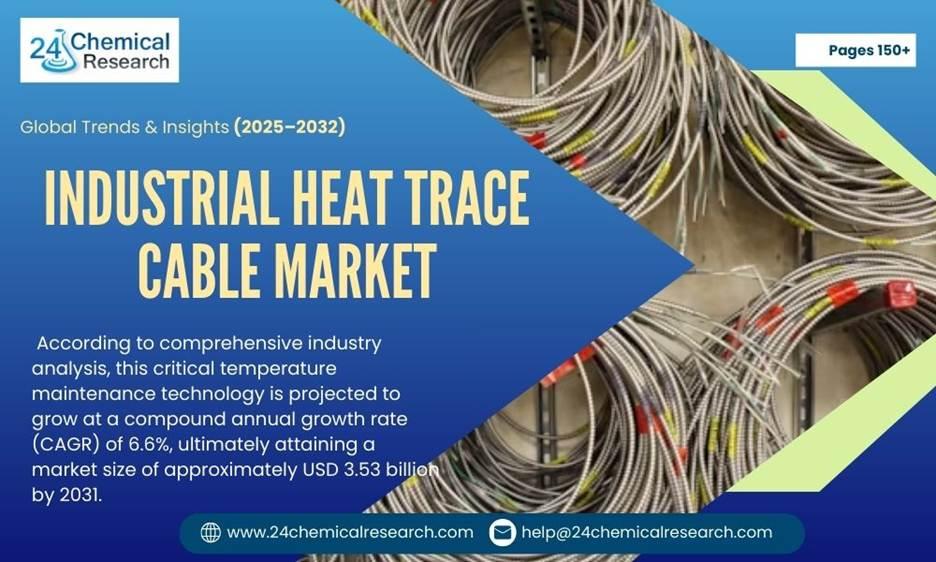Global Industrial Heat Trace Cable Market continues to demonstrate robust expansion, reaching a valuation of USD 2.28 billion in 2024. According to comprehensive industry analysis, this critical temperature maintenance technology is projected to grow at a compound annual growth rate (CAGR) of 6.6%, ultimately attaining a market size of approximately USD 3.53 billion by 2031. This sustained growth trajectory stems from escalating demand across energy-intensive industries where process temperature control is mission-critical.
Industrial heat trace systems represent specialized electrical solutions that prevent freezing and maintain optimal temperatures in pipes, vessels, and industrial equipment. These systems utilize self-regulating polymer technology or mineral-insulated heating elements that automatically adjust output based on ambient conditions. Their importance has grown exponentially as industries face increasingly stringent operational and safety requirements, particularly in extreme climate operations.
Download FREE Sample Report: https://www.24chemicalresearch.com/download-sample/296951/industrial-heat-trace-cable-market
Global Market Insights and Regional Dynamics
North America currently dominates the industrial heat trace landscape, accounting for nearly 38% of global market share. This leadership position reflects both the region's extensive hydrocarbon infrastructure and its rigorous industrial safety standards. The U.S. particularly stands out with major shale gas developments and aging pipeline networks requiring thermal management upgrades. Canadian operations in Alberta's oil sands and Arctic energy projects further bolster regional demand for freeze protection solutions.
Meanwhile, Asia-Pacific emerges as the fastest-growing regional market, projected to expand at 7.8% CAGR through 2031. China's massive petrochemical expansion and India's refinery modernization programs drive this growth, though adoption rates vary significantly based on local industrial maturity. Europe maintains steady demand through its chemical and pharmaceutical sectors, where EX-certified heat trace systems are mandatory for hazardous areas
Strategic Insights & Innovation Outlook
The industrial heat trace cable market is evolving rapidly as technological innovation and energy efficiency mandates reshape design and deployment strategies. Leading manufacturers are integrating advanced self-regulating polymers, AI-driven control systems, and IoT connectivity to deliver predictive maintenance, optimize energy consumption, and improve operational safety in extreme environments.
A key trend is the adoption of digital twin technology for pipeline and equipment heating systems, enabling real-time performance simulation and reducing unplanned downtime. Modular cable architectures with quick-connect terminations are streamlining installation and reducing total project costs, making electric heat trace more competitive against steam tracing in certain applications.
Sustainability considerations are driving the development of low-emission manufacturing processes and recyclable insulation materials. In parallel, hybrid heating solutions—combining electric heat trace with complementary technologies such as heat recovery—are gaining traction in energy-intensive industries seeking to minimize operating expenses.
Regional players are leveraging local climate-specific expertise, particularly in Arctic and desert operations, to provide tailored solutions that meet both operational and regulatory requirements. As hydrogen infrastructure, cold chain logistics, and renewable energy plants expand globally, the market’s growth will increasingly hinge on customized, application-specific systems that combine high efficiency, compliance readiness, and long service life.
.
Market Growth Factors and Opportunity Landscape
Three primary factors propel the industrial heat trace market forward. First, the oil & gas sector's insatiable need for reliable pipeline heating accounts for 35% of total demand. Recent Arctic exploration projects and LNG infrastructure development have created specialized requirements for low-temperature operation. Second, stringent safety regulations like ATEX and IECEx certifications force continuous upgrades to intrinsically safe systems. Finally, energy efficiency mandates are driving adoption of smart, self-regulating cables that can reduce power consumption by up to 30%.
Emerging opportunities abound in renewable energy applications, particularly for hydrogen infrastructure and solar thermal plants where precise temperature control is essential. The pharmaceutical industry's expanding cold chain logistics also presents new application areas for temperature-maintained transportation solutions. Digital integration represents another frontier, with IoT-enabled heat trace systems providing predictive maintenance capabilities and operational analytics.
Challenges Affecting Market Expansion
Despite strong growth fundamentals, the industry faces notable headwinds. High installation costs averaging $50-300 per linear foot create barriers for small and medium enterprises, particularly in developing markets. Technical complexity presents another hurdle, with proper system design requiring specialized engineering expertise that remains scarce globally. Supply chain volatility for critical materials like copper and nickel further complicates manufacturing stability.
The market also contends with competition from alternative technologies. Steam tracing maintains a strong foothold in refineries where steam is readily available, while electric heating blankets gain traction in vessel applications. These alternatives fragment the market and pressure heat trace manufacturers to continuously demonstrate superior value propositions in specific applications.
Market Segmentation Analysis :
Market Segmentation by Type
- Self-Regulating Heat Trace
- Hazardous Area Heat Trace
- Series Resistance Long Line
- Constant Wattage Heat Trace
- Mineral Insulated Heat Trace
- Other
Market Segmentation by Application
- Petroleum
- Chemical Industry
- Electricity
- Medicine
- Ships
- Other
Market Segmentation by End User
- Oil & Gas
- Chemicals
- Manufacturing
- Marine
- Power Generation
Key Market Players
- Pentair Thermal Management
- Thermon Group Holdings Inc.
- Emerson Electric
- Chromalox, Inc.
- Bartec Group
- nVent
- eltherm GmbH
- BriskHeat Corporation
- Heat Trace Products
- Valin Corporation
Report Scope
This report provides a comprehensive analysis of the global industrial heat trace cable market from 2024 to 2031, featuring:
- Detailed market size estimations and growth forecasts
- In-depth segmentation analysis by type, application, and end-use sector
- Regional breakdown with country-specific insights
- Competitive landscape assessment of key players
- Technology trends and innovation trajectories
- Regulatory environment impact analysis
- Supply chain and pricing dynamics
The research methodology combines primary interviews with industry experts, extensive secondary research, and proprietary data modeling to deliver accurate, actionable market intelligence.
Get Full Report Here: https://www.24chemicalresearch.com/reports/296951/industrial-heat-trace-cable-market
Access more Related report-
Timber Formwork Market Size,Demand & Supply, Regional and Competitive Analysis 2025-2032
Contact Us:
Email: help@24chemicalresearch.com
International: +1(332) 2424 294 | Asia: +91 9169162030



